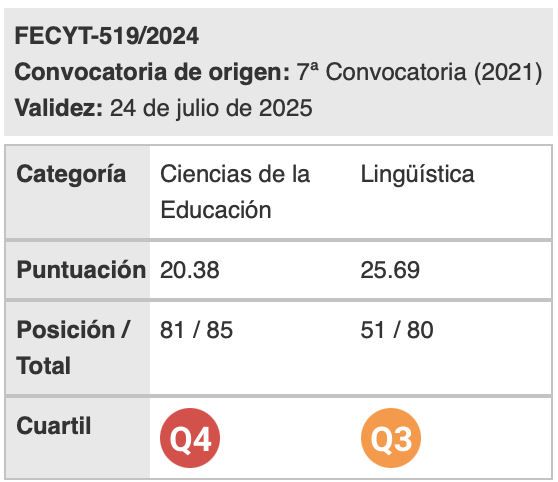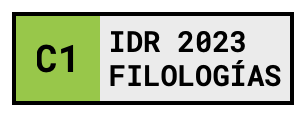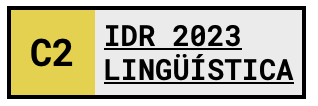Ensuring uniformity of content and assessment in on-site ESP university courses through ICT
Palabras clave:
ICT, ESP, uniformity of assessment, commercial English, multi-section coursesResumen
The paper presents an experience of use of ICT intended to overcome some of the problems currently plaguing ESP teaching at third level in Spain, namely student overcrowding, rising grade appealing, inadequacy and/or datedness of methodologies and syllabi, multi-campus lecturing, and disproportionate course management and assessment workload. The experience was developed in English for Commerce I, an on-site ESP required course in the curriculum of the BA in Commerce and Marketing currently taught at the University of Oviedo, during the first term of the year 2016/2017. The main aims were (1) to update the contents and methods of the course so that they allowed for significant, collaborative and autonomous learning of commercial English; (2) to significantly reduce the time the lecturers devoted to preparing, grading and reviewing tests, as well as handling student complaints, and (3) to greatly improve staff coordination so that uniformity of content and assessment could be guaranteed. The results show that aims (1) and (3) were fully met. As regards aim (2), even though ICT did reduce the time spent reviewing tests and handling complaints, the authors feel that the preparation of computer-assisted, on-site exams took longer than expected. Whereas the literature on the use of ICT in education mainly focuses on student motivation and engagement, the experience also bears out that ICT can be effectively used to combat student unhappiness by ensuring uniformity of content and assessment across sections in multi-section courses.Descargas
Citas
Ahmed, M.K. (2014). The ESP Teacher: Issues, Tasks and Challenges. English for Specific Purposes World, 15.42, 1-33. <http://www.esp-world.info/Articles_42/Documents/Ahmed.pdf> [25/04/2018].
Alfaro Rocher, I.J. & Pérez Boullosa, A. (2011). Un estudio acerca de la dedicación docente del profesorado universitario en el marco del Espacio Europeo de Educación Superior. Revista Electrónica Interuniversitaria de Formación del Profesorado, 14.4, 41-56. <http://aufop.com/aufop/uploaded_files/articulos/1324595303.pdf> [10/05/2018].
Belcher, D.D. (2006). English for Specific Purposes: Teaching to Perceived Needs and Imagined Futures in Worlds of Work, Study, and Everyday Life. TESOL Quarterly, 40.1, 133-156. <http://www.jstor.org/stable/40264514> [27/04/2018].
Birjandi, P. & Nushi, M. (2010). Non-Verbal Communication in Models of Communicative Competence and L2 Teachers’ Rating. Journal of English Studies, 1.1, 3-22. <http://www.sid.ir/en/journal/ViewPaper.aspx?FID=1024220100101> [25/04/2018].
Canale, M. & Swain, M. (1980). Theoretical Bases of Communicative Approaches to Second Language Teaching and Testing. Applied Linguistics, 1.1, 1-47.
Carretero, A. (2005). Las TICs en el aula de Inglés: un proyecto de trabajo. Quaderns Digitals. <http://www.quadernsdigitals.net/index.php?accionMenu=hemeroteca.VisualizaArticuloIU.visualiza&articulo_id=8656> [10/01/2018].
De Juan, P. (2012). Uso de las nuevas tecnologías en la enseñanza de lenguas extranjeras. Revista de Lenguas para Fines Específicos, 18, 183-212. <http://www.webs.ulpgc.es/lfe/resources/0233536_00018_0008.pdf> [03/01/2018].
De Miguel Díaz, M. (2003). Calidad de la enseñanza universitaria y desarrollo profesional del profesorado. Revista de Educación, 331, 13-34.
Dejebbari, Z. (2015). Immerse into the Digital Age: New Technological Tools and New Challenges for the Improvement of Language Teaching. English for Specific Purposes World, 47, 1-16. <http://www.esp-world.info/Articles_47/47_DJEBBARI.pdf> [30/04/2018].
Díaz, A. R. & Hortiguera, H. (2016). TELL-ING IT LIKE IT IS: Practical implications from a critical stance on technology-enhanced language learning. Revista de Lenguas para Fines Específicos, 22.1, 54-79. <http://ojsspdc.ulpgc.es/ojs/index.php/LFE/article/view/472/456> [29/04/2018].
Dudley-Evans, T. & St. John, M. (1998). Developments in English for Specific Purposes. A Multidisciplinary Approach. Cambridge: Cambridge University Press.
Gao, J. (2007). Designing an ESP course for Chinese University Students of Business. The Asian ESP Journal, 3.1, 98-107. <http://asian-esp-journal.com/wp-content/uploads/2016/01/AESp-Volume-3-Issue-1-Apri-2007.pdf> [25/04/2018].
García, S. (2014). El aprendizaje autónomo y comunicativo de inglés para fines profesionales en el Grado de Educación Primaria a través de herramientas virtuales. Pulso, 37, 249-268. <https://dialnet.unirioja.es/servlet/articulo?codigo=4958987> [07/01/2018].
Gibbs, G. (1995) The relationship between quality in research and quality in teaching. Quality in Higher Education, 1.2, 147-157.
Halliday, M. et al. (1964). The Linguistic Sciences and Language Teaching. London: Longmans.
Hernández, M.P. (2012). La integración de las TIC en la clase de ELE. Panorama de una (r)evolución. Revista Internacional de Lenguas Extranjeras, 1, 63-99. <https://revistes.urv.cat/index.php/rile/article/view/8> [03/01/2018].
Hutchinson, T. & Waters, A. (1987). English for Specific Purposes. Cambridge: Cambridge University Press.
Kelsen, B. (2009). Teaching EFL to the iGeneration: A Survey of Using YouTube as Supplementary Material with College EFL Students in Taiwan. CALL-EJ Online, 10.2. <http://callej.org/journal/10-2/kelsen.html> [01/05/2018].
Lansford, L. (2014). Authentic materials in the classroom: the advantages. World of Better Learning. <http://www.cambridge.org/elt/blog/2014/05/16/authentic-materials-classroom-advantages/> [16/05/2018].
Lesiak-Bielawska, E.D. (2015). Technology in ESP Pedagogy. English for Specific Purposes World, 16.48, 1-23. <http://www.esp-world.info/Articles_48/Lesiak_Bielawska_E.pdf> [30/042018].
Martínez Flor, A. & Fernández Guerra, A. (2005). Collaborative discourse and the teachers' feedback in the EFL classroom: the case of suggestions. In P. Salazar et al. (Eds.), Teaching and learning the English Language from a discourse perspective (pp. 91-110). Castellón: Universitat Jaume I.
Mejía, G. (2016). Promoting language learning: The use of mLearning in the Spanish classes. Revista de Lenguas para Fines Específicos, 22.1, 80-99. <https://ojsspdc.ulpgc.es/ojs/index.php/LFE/article/view/494/457> [29/04/2018].
Pinkman, K. (2005). Using Blogs in the Foreign Language Classroom: Encouraging Learner Independence. The JALT CALL Journal, 1.1, 12-24. [10/04/2018].
Robinson, P. (1991). ESP Today: A Practitioner’s Guide. London: Prentice Hall.
Rodríguez-Piñero, A.I. & García, M. (2009). Lenguas de especialidad y lenguas para fines específicos: precisiones terminológicas y conceptuales e implicaciones didácticas. In A. Vera & I. Martínez (Eds.), El español en contextos específicos: enseñanza e investigación (pp. 907-932). Comillas: Fundación Comillas.
Salinas, J. (2004). Innovación docente y uso de las TIC en la enseñanza universitaria. Universidad y Sociedad del Conocimiento, 1.1, 1-16. <http://www.redalyc.org/articulo.oa?id=78011256001> [10/01/2018].
Simon, L. (2014). La dedicación docente del profesorado universitario: una propuesta para su computación. In J. Rodríguez (Ed.), Experiencias en la adaptación al EEES (pp. 581-592). Madrid: McGraw-Hill.
Simons, M. (2010). Perspectiva didáctica sobre el uso de las TIC en clase de ELE. MarcoELE. Revista de didáctica ELE, 11, pp. 1-21. <http://marcoele.com/descargas/11/simons-tic.pdf> [02/01/2018].
Surkamp, C. (2014). Non-Verbal Communication: Why We Need It in Foreign Language Teaching and How We Can Foster It with Drama Activities. Scenario, 8.2, 12-27. <http://research.ucc.ie/scenario/2014/02/Surkamp/03/en> [18/04/2018].
Swain, M. et al. (2002). Peer-peer dialogue as a means of second language learning. Annual Review of Applied Linguistics, 22, 171–185. <https://www.cambridge.org/core/journals/annual-review-of-applied-linguistics/article/9-peerpeer-dialogue-as-a-means-of-second-language-learning/F451FCE38062F9C4AB4FE881347404F2> [20/04/2018].
Teaching English (2006). Communicative approach. <https://www.teachingenglish.org.uk/article/communicative-approach> [16/05/2018].
Torres, D. et al. (2003). Recursos. In I. Hearn & A. Garcés (Eds.), Didáctica del Inglés (pp. 222-263). Madrid: Pearson Prentice Hall.
Torres-Corrales, J.C. et al. (2017). Integración de las TIC en la enseñanza del inglés con fines académicos e investigativos. Educación y Sociedad, 15.1, 25-39. <http://revistas.unica.cu/index.php/edusoc/article/view/477/pdf_49> [05/01/2018].
Descargas
Publicado
Cómo citar
Número
Sección
Licencia
Aquellos autores/as que tengan publicaciones con esta revista, aceptan los términos siguientes:
- Los autores/as conservarán sus derechos de autor y garantizarán a la revista el derecho de primera publicación de su obra, el cuál estará simultáneamente sujeto a la Licencia de reconocimiento de Creative Commons que permite a terceros compartir la obra siempre que se indique su autor y su primera publicación esta revista.
- Los autores/as podrán adoptar otros acuerdos de licencia no exclusiva de distribución de la versión de la obra publicada (p. ej.: depositarla en un archivo telemático institucional o publicarla en un volumen monográfico) siempre que se indique la publicación inicial en esta revista.
- Se permite y recomienda a los autores/as difundir su obra a través de Internet (p. ej.: en archivos telemáticos institucionales o en su página web) antes y durante el proceso de envío, lo cual puede producir intercambios interesantes y aumentar las citas de la obra publicada. (Véase El efecto del acceso abierto).

Revista de Lenguas para fines específicos is licensed under a Creative Commons Reconocimiento-NoComercial-SinObraDerivada 4.0 Internacional License.






















